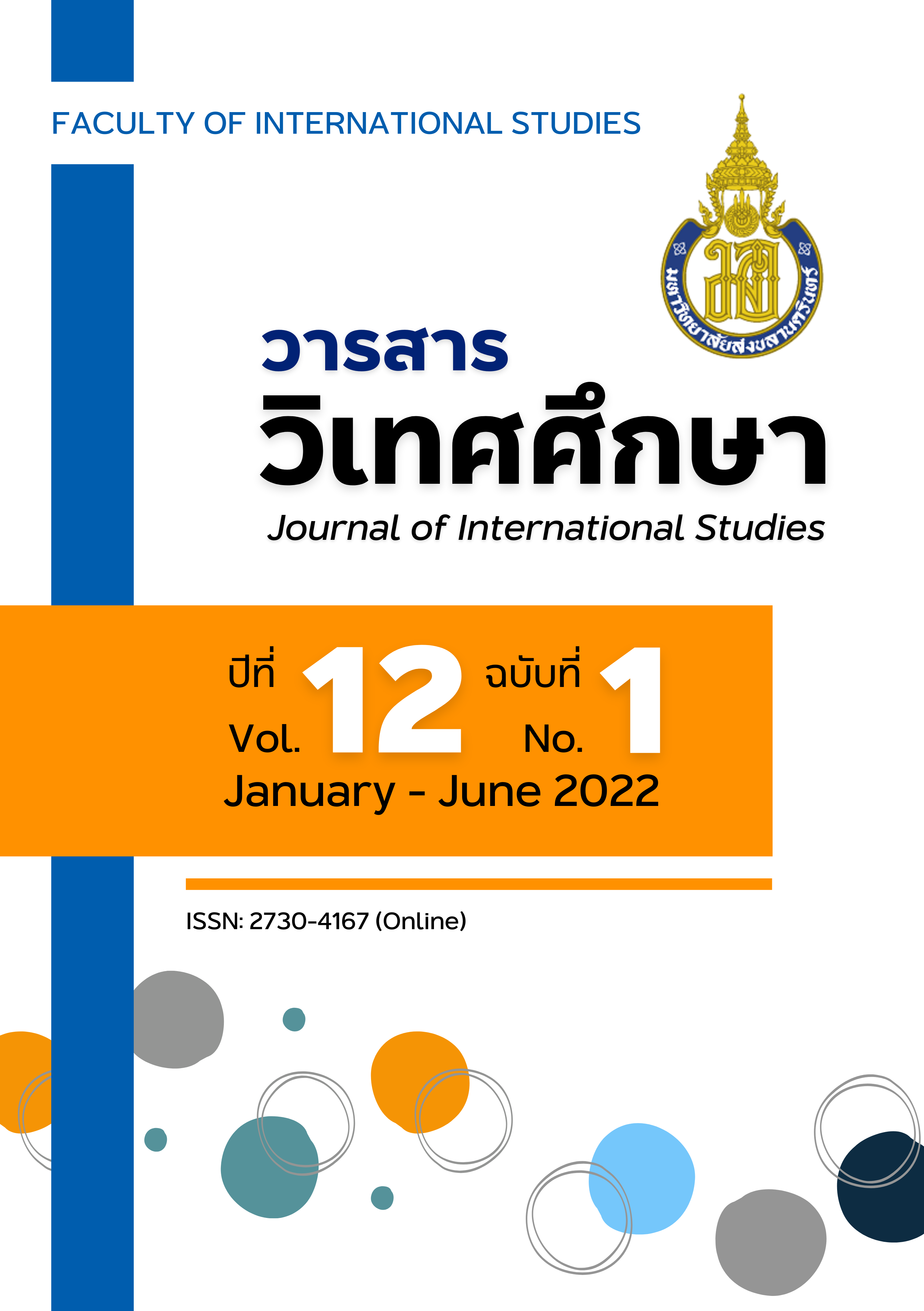Language Stategies Showing Humour in Kuanmuk Narrative and Dialogue in the Royal Khon Performance
Main Article Content
Abstract
This article aims to study and analyze language strategies showing humour in Kuanmuk narrative and dialogue in the Royal Khon Performance in 2011, 2013, 2014 and 2018. Four years of Khon Performance data was taken from live performance tapes and dialogues were transcribed into text to analyze. The research found that 9 language strategies were used as follows: 1) Teasing (Direct and indirect teasing) 2) Contradiction 3) Obscene word 4) Literary parody 5) Using symbols 6) Conflict 7) Using language creates humour (Using foreign languages, dialects and volume to give a clear picture) 8) Unexpected ending and 9) Abbreviation. These language tactics are intriguing audiences to follow the show. Although the humour presentation is simple, using meaningful words and language strategies made people laugh out loud. Moreover, violent words from the presentation has been softened to create the sense of humour. It can be considered a linguistic phenomenon that indicates the potential of humour in various media clearly.
Article Details

This work is licensed under a Creative Commons Attribution-NonCommercial-NoDerivatives 4.0 International License.
Statements and opinions expressed in articles herein are those of the authors and do not necessarily reflect the position of the editors or publisher.
Article, information, text, image, etc. which are published in Journal of International Studies, belong to Journal of International Studies. If anybody or any organization would like to use part or whole of them, they must receive written permission from Journal of International Studies before usage.
References
กาญจนา เจริญเกียรติบวร. (2548). การวิเคราะห์วาทกรรมเรื่องตลกภาษาไทย. วิทยานิพนธ์อักษรศาสตรดุษฎีบัณฑิต, จุฬาลงกรณ์มหาวิทยาลัย.
คณะศิลปศาสตร์ มหาวิทยาลัยธรรมศาสตร์. (2508). เอกสารประกอบการศึกษาวิชาภาษาไทย. กรุงเทพมหานคร: มหาวิทยาลัยธรรมศาสตร์.
ชนัญญา ใยลออ. (2544). การสื่อสารอารมณ์ขันของนักแสดงตลก รายการโทรทัศน์ก่อนบ่ายคลายเครียด. วิทยานิพนธ์ปริญญามหาบัณฑิต, บัณฑิตวิทยาลัย จุฬาลงกรณ์มหาวิทยาลัย.
ญาดา ชาญบัญชี. (2551). กลวิธีการใช้ภาษาในงานเขียนอารมณ์ขันเกตุเสพย์สวัสดิ์ ปาลกะวงศ์ ณ อยุธยา. ปริญญานิพนธ์การศึกษามหาบัณฑิต, บัณฑิตวิทยาลัย มหาวิทยาลัยศรีนครินทรวิโรฒ.
ธิดา โมสิกรัตน์. (2526). เอกสารการสอนชุดวิชาภาษาไทย 4 วรรณคดีในหน่วยที่ 1-7 (พิมพ์ครั้งที่ 2). กรุงเทพมหานคร: ฝ่ายการพิมพ์มหาวิทยาลัยสุโขทัยธรรมาธิราช.
ธิติสรณ์ ศรีธาดา. (2542). การศึกษาวิเคราะห์การใช้ภาษาในการแสดงตลก. ปริญญานิพนธ์การศึกษามหาบัณฑิต, บัณฑิตวิทยาลัย มหาวิทยาลัยศรีนครินทรวิโรฒ.
ปวริส มินา. (2561). กลวิธีการสร้างสรรค์ความตลกในรายการโทรทัศน์ไทย. วารสารมหาวิทยาลัยศิลปากร, 11(3), 2300-2313.
วิกิพีเดีย สารานุกรมเสรี. (2563). คณะรักษาความสงบแห่งชาติแห่งชาติ. ค้นเมื่อ 10 มิถุนายน 2563, จาก https://th.wikipedia.org/wiki/คณะรักษาความสงบแห่งชาติ
วิกิพีเดีย สารานุกรมเสรี. (2563). แนวร่วมประชาธิปไตยต่อต้านเผด็จการแห่งชาติ. ค้นเมื่อ 10 มิถุนายน 2563, จาก https://th.wikipedia. org/wiki/แนวร่วมประชาธิปไตยต่อต้านเผด็จการแห่งชาติ
สิทธา พินิจภูวดล.(2515). ความรู้ทั่วไปทางวรรณกรรมไทย. กรุงเทพมหานคร: มหาวิทยาลัยรามคำแหง.
หนึ่งฤทัย ชวนะลิขิกร. (2554). อารมณ์ขันในข้อความท้ายรถ: เสน่ห์ทางภาษาที่ไม่ควรมองข้าม. วารสารสถาบันวัฒนธรรมและศิลปะ (สาขามนุษยศาสตร์และสังคมศาสตร์) มหาวิทยาลัยศรีนครินทรวิโรฒ. 13(1), 69-77.
อธิปัตย์ นิตย์นรา, พิชัย แก้วบุตร, ชวาลิน เพ่งบุญ, และนพวรรณ เมืองแก้ว. (2563). การวิเคราะห์บทพากย์-เจรจาแบบกวนมุขในโขนพระราชทาน. วารสารมนุษยศาสตร์และสังคมศาสตร์ มหาวิทยาลัยราชภัฏอุบลราชธานี. 11(2), 64-77.
อุมาภรณ์ สังขมาน. (2559). กลวิธีทางภาษาในวัจนกรรมเสียดสีเพื่อสร้างความตลกขบขันของไทย. วารสารมนุษยศาสตร์. 23(1), 154-178.
Chiaro, D. (1992). The Language of Jokes. London: Routledge.

